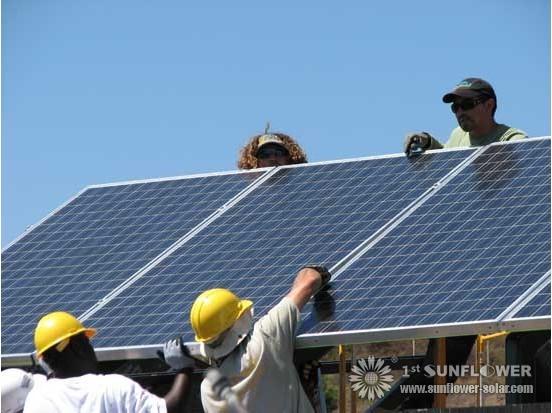
It is not uncommon for a remote site to be checked but once per year. Under most conditions, normal rainfall is sufficient to keep the Solar Panel glass clean.
Clean the glass with a soft cloth using mild detergent and water. Solar Panel that are mounted, fiat ( 0°tilt andle) should be cleaned more often, as they will not self-clean as effectively as Solar Panel mounted at a 15°tilt or greater.
It is advisable to perform periodic inspection of the Solar Panel for damage to glass, backskin, frame and support structure. Check electrical connections for loose connections and corrosion. Check if mounting support structure and modules are loose. Check connections of cables, connectors, and grounding. Change Solar Panel must be the same kind and type, if need. Solar Panel can operate effectively without ever being washed, although removal of dirt from the front glass can increase output. The glass can be washed with a wet sponge or cloth, wear rubber gloves for electrical insulation.
Solar Panel Safety precautions
Solar Panel installation and operation should be performed by qualified personnel only. Children should not be allowed near the solar electric installation.
Avoid electrical hazards when installing, wiring, operating and maintaining the module. Solar Panel produce DC electricity when exposed to light and therefore can produce an electrical shock or burn. Solar Panel produce voltage even when not connected to an electrical circuit or load. Solar Panel produce nearly full voltage when exposed to as little as 5% of full sunlight and both current and power increase with light intensity. Do not touch live parts of cables and connectors. As an added precaution, use insulated tools and rubber gloves when working with Solar Panel in sunlight.
Fall of Solar Panel from high place will cause death, injury or damage. Do not drop Solar Panel or allow objects to fall on Solar Panel, never leave a Solar Panel unsupported or unsecured. If a module should fail, the glass can break a Solar Panel with broken glass cannot be repaired and must not be used.
When installing or working with Solar Panel or wiring, cover module face completely with opaque material to halt production of electricity. Solar Panel have no on/off switch. Solar Panel when exposed to sunlight generate high voltage and are dangerous, Solar Panel can be rendered inoperative only by removing them from sunlight, or by fully covering the front surface with opaque cloth, cardboard, or other completely opaque material, or by working with Solar Panel face down on a smooth, flat surface when installing or maintaining.
Do not artificially concentrate sunlight on the Solar Panel.
Solar Panel can produce higher output than the rated specifications. Industry standard ratings are made at conditions of 1000W/㎡ and 25℃ cell temperature. Reflection from snow or water can increase sunlight and therefore boost current and power. In addition, colder temperatures can substantially increase voltage and power.
Solar Panel are intended for use in terrestrial applications only, thus excluding aerospace or maritime conditions or use with sunlight concentration.
It is recommended that the Solar Panel remains packed in the box until time of installation.
Work only under dry conditions, with a dry Solar Panel and tools, since sparks may be produced, do not install Solar Panel where flammable gases or vapors are present.
Do not drill holes into Solar Panel frame as it will void warranty. Solar Panel ate constructed frame as it will void warranty.
Handled with care, if the front glass is broken or if the polymer backskin is tom, contact with any module surface or the frame can produce electrical shock. Particularly when the Solar Panel is wet, broken or damaged modules must be disposed of properly. Do not disassemble, bend, impact by sharp objects, walk on, and throw or drop etc. keep back surface free from foreign objects. Avoid sharp edges.
Use Solar Panel for its intended function only follows all Solar Panel manufacturers’ instructions. Do not disassemble the module, or remove any part or label installed by the manufacturer. Do not treat the back of the Solar Panel with paint or adhesives.
If not otherwise specified, it is recommended that requirements of the latest local, national or regional electrical codes be followed.
Retain this installation manual for future reference.
Notes
The electrical characteristics are within ±5 percent of the indicated values of Isc, Voc, and Pmax under standard test conditions (irradiance of 100mW/㎝2, AM 1.5 spectrum, and a cell temperature of 25℃(77°F).
Under normal conditions, a photovoltaic Solar Panel is likely to experience conditions that produce more current and/or voltage than reported at standard test conditions. Accordingly, the values of Isc and Voc marked on this module should be multiplied by a factor of 1.25 when determining component voltage ratings, conductor ampacities, fuse sizes, and size of controls connected to the PV output.